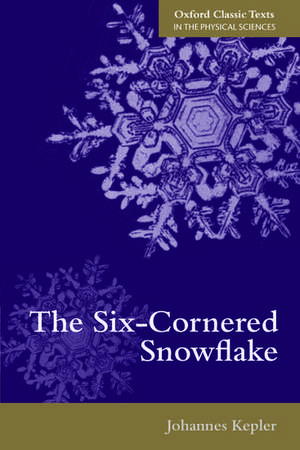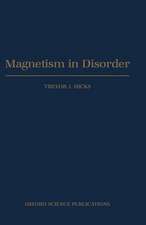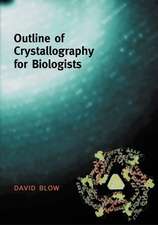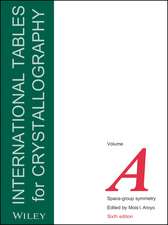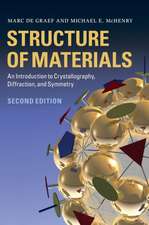The Six-Cornered Snowflake: Oxford Classic Texts in the Physical Sciences
Autor Johannes Kepler Traducere de C. Hardieen Limba Engleză Paperback – 10 apr 2014
Din seria Oxford Classic Texts in the Physical Sciences
- 25%
 Preț: 548.72 lei
Preț: 548.72 lei - 19%
 Preț: 700.08 lei
Preț: 700.08 lei - 18%
 Preț: 713.12 lei
Preț: 713.12 lei - 26%
 Preț: 545.53 lei
Preț: 545.53 lei - 28%
 Preț: 466.65 lei
Preț: 466.65 lei - 17%
 Preț: 360.60 lei
Preț: 360.60 lei - 15%
 Preț: 580.31 lei
Preț: 580.31 lei - 22%
 Preț: 461.80 lei
Preț: 461.80 lei - 24%
 Preț: 446.89 lei
Preț: 446.89 lei - 33%
 Preț: 533.86 lei
Preț: 533.86 lei - 33%
 Preț: 627.04 lei
Preț: 627.04 lei - 18%
 Preț: 300.99 lei
Preț: 300.99 lei - 17%
 Preț: 353.76 lei
Preț: 353.76 lei - 24%
 Preț: 559.97 lei
Preț: 559.97 lei - 28%
 Preț: 464.07 lei
Preț: 464.07 lei - 28%
 Preț: 637.10 lei
Preț: 637.10 lei - 30%
 Preț: 599.70 lei
Preț: 599.70 lei - 30%
 Preț: 517.66 lei
Preț: 517.66 lei - 22%
 Preț: 439.09 lei
Preț: 439.09 lei - 33%
 Preț: 660.48 lei
Preț: 660.48 lei - 15%
 Preț: 550.76 lei
Preț: 550.76 lei - 18%
 Preț: 405.34 lei
Preț: 405.34 lei - 17%
 Preț: 587.57 lei
Preț: 587.57 lei - 12%
 Preț: 481.66 lei
Preț: 481.66 lei - 20%
 Preț: 536.32 lei
Preț: 536.32 lei - 27%
 Preț: 452.14 lei
Preț: 452.14 lei - 13%
 Preț: 344.96 lei
Preț: 344.96 lei - 20%
 Preț: 409.86 lei
Preț: 409.86 lei -
 Preț: 308.36 lei
Preț: 308.36 lei
Preț: 162.51 lei
Preț vechi: 196.68 lei
-17% Nou
Puncte Express: 244
Preț estimativ în valută:
31.11€ • 33.80$ • 26.15£
31.11€ • 33.80$ • 26.15£
Carte tipărită la comandă
Livrare economică 09-15 aprilie
Preluare comenzi: 021 569.72.76
Specificații
ISBN-13: 9780198712497
ISBN-10: 0198712499
Pagini: 96
Dimensiuni: 163 x 236 x 11 mm
Greutate: 0.17 kg
Editura: Oxford University Press
Colecția OUP Oxford
Seria Oxford Classic Texts in the Physical Sciences
Locul publicării:Oxford, United Kingdom
ISBN-10: 0198712499
Pagini: 96
Dimensiuni: 163 x 236 x 11 mm
Greutate: 0.17 kg
Editura: Oxford University Press
Colecția OUP Oxford
Seria Oxford Classic Texts in the Physical Sciences
Locul publicării:Oxford, United Kingdom
Recenzii
Review from previous edition This exceedingly well produced little book is the first English translation of Johannes Kepler's (1571-1630) truly remarkable, although still little-known, essay 'De nive sexangula'. ... This fine English translation will no doubt greatly help to recall Kepler's early contribution.
This little known essay of Kepler poses (for perhaps the first time in the history of Western thought) the basic questions: "Why do snowflakes have hexagonal symmetry?" ... The book contains the Latin text and an English translation of Kepler's essay, as well as a lucid article by B. J. Mason on present views on the symmetry of ice crystals.
In the present edition the modernized Latin text is confronted with the first English translation ever made of this lively essay. Kepler's numerous allusions are explained in carefully prepared notes while the synopsis helps the reader to follow his thread of thought.
This is a beautiful little book of great fascination to anyone interested in crystallography, history of science, the history of geometry - or snowflakes.
This translation is intended to display the historical, literary, scientific, and philosophical value of Kepler's essay. It portrays an exceptional scientist who recognizes a problem, discusses several possible solutions, rejects them all, and leaves the solution of the problem to future chemists. A glimpse into the thought processes of a man like Kepler, in an age of scientific awakening, should interest scientists, historians, and anyone who wonders why natural objects are the shape they are.
Kepler was a crucial figure in the struggle to establish an intellectual order in the world. The brilliance with which he converted Pythagorean preconceptions into the living thought of science, the prescience which identified the most significant problems, precisely because they are the most beautiful problems - these qualities of Kepler's mind are all exemplified and revealed in the few pages of the "Snowflake". ... Colin Hardie's translation and the handsome book which makes it available to us puts us all in his debt.
Mr. L. L. Whyte and Professor B. J. Mason make clear in learned and pertinent essays that this was the first scientific examination in Europe of the regular shape of snowflakes. It was the first step towards the modern science of crystallography, and as such has some importance in the history of science.
This little known essay of Kepler poses (for perhaps the first time in the history of Western thought) the basic questions: "Why do snowflakes have hexagonal symmetry?" ... The book contains the Latin text and an English translation of Kepler's essay, as well as a lucid article by B. J. Mason on present views on the symmetry of ice crystals.
In the present edition the modernized Latin text is confronted with the first English translation ever made of this lively essay. Kepler's numerous allusions are explained in carefully prepared notes while the synopsis helps the reader to follow his thread of thought.
This is a beautiful little book of great fascination to anyone interested in crystallography, history of science, the history of geometry - or snowflakes.
This translation is intended to display the historical, literary, scientific, and philosophical value of Kepler's essay. It portrays an exceptional scientist who recognizes a problem, discusses several possible solutions, rejects them all, and leaves the solution of the problem to future chemists. A glimpse into the thought processes of a man like Kepler, in an age of scientific awakening, should interest scientists, historians, and anyone who wonders why natural objects are the shape they are.
Kepler was a crucial figure in the struggle to establish an intellectual order in the world. The brilliance with which he converted Pythagorean preconceptions into the living thought of science, the prescience which identified the most significant problems, precisely because they are the most beautiful problems - these qualities of Kepler's mind are all exemplified and revealed in the few pages of the "Snowflake". ... Colin Hardie's translation and the handsome book which makes it available to us puts us all in his debt.
Mr. L. L. Whyte and Professor B. J. Mason make clear in learned and pertinent essays that this was the first scientific examination in Europe of the regular shape of snowflakes. It was the first step towards the modern science of crystallography, and as such has some importance in the history of science.
